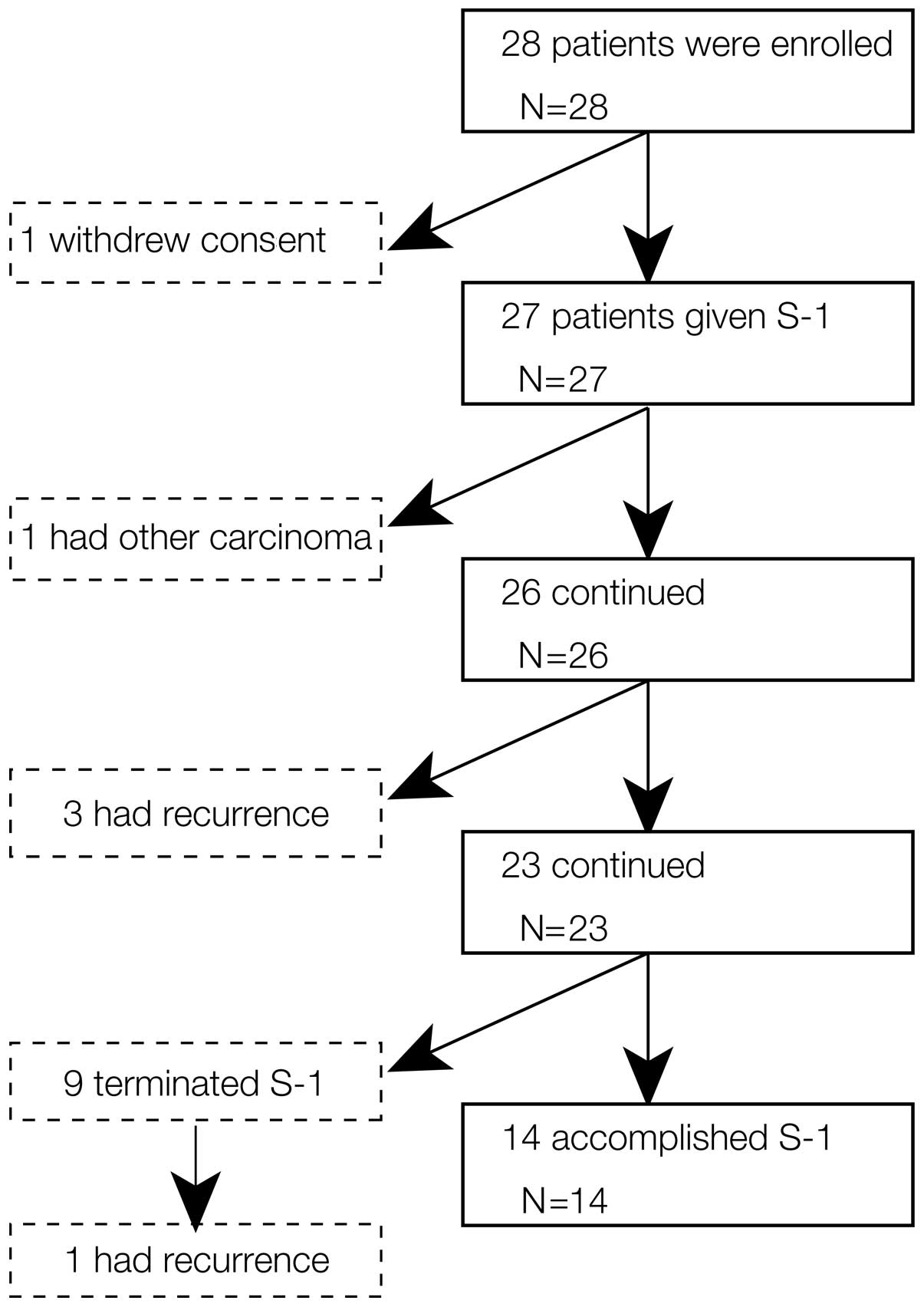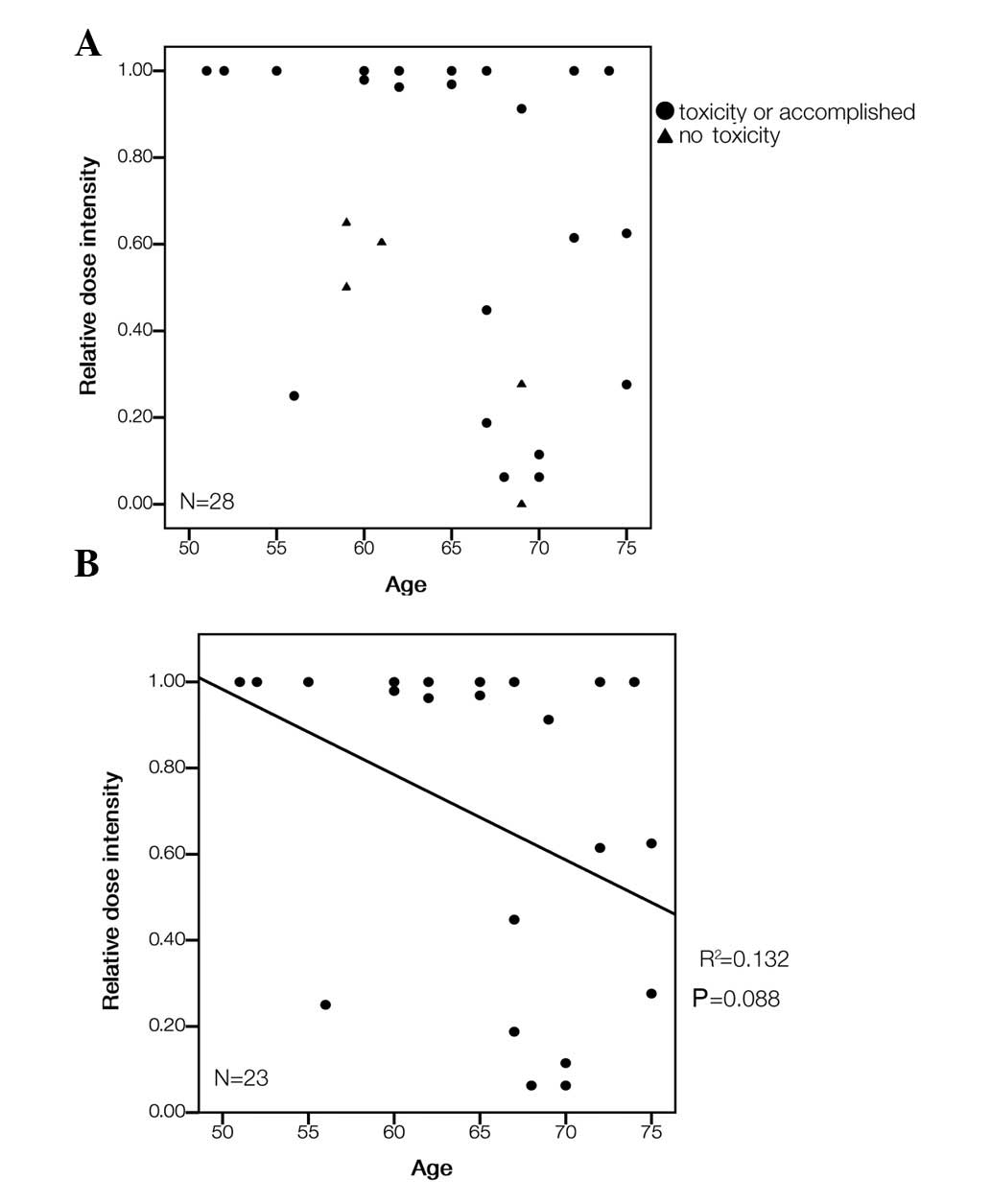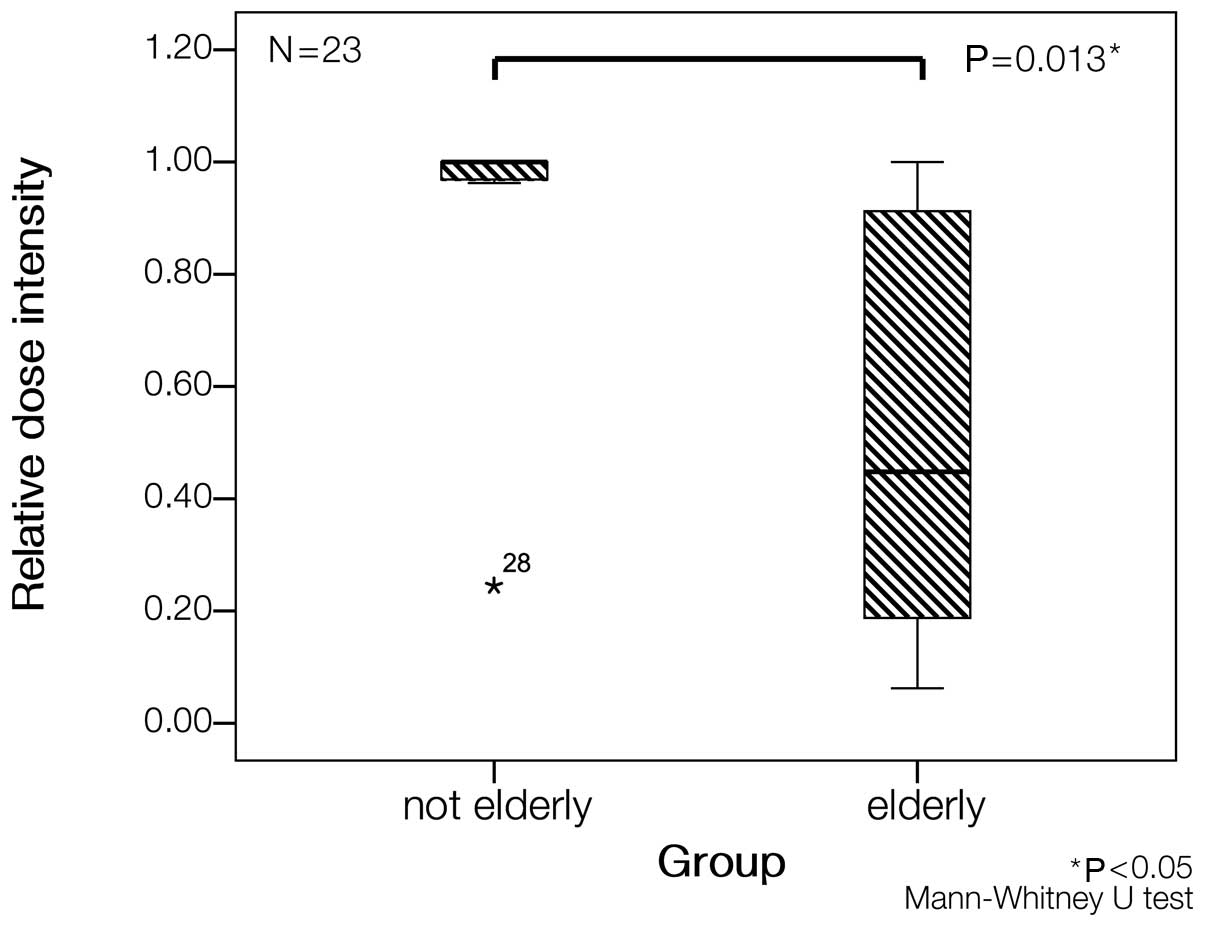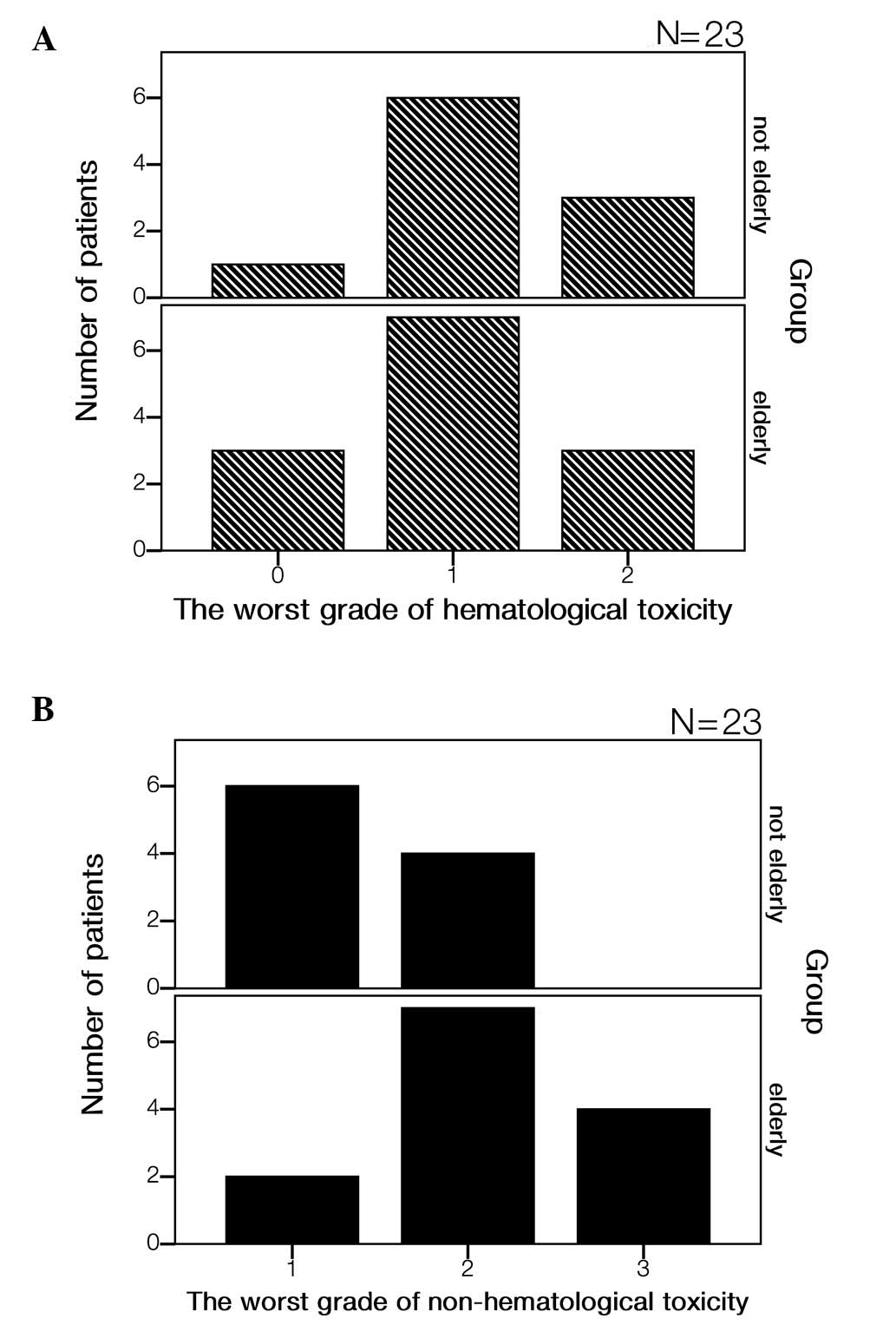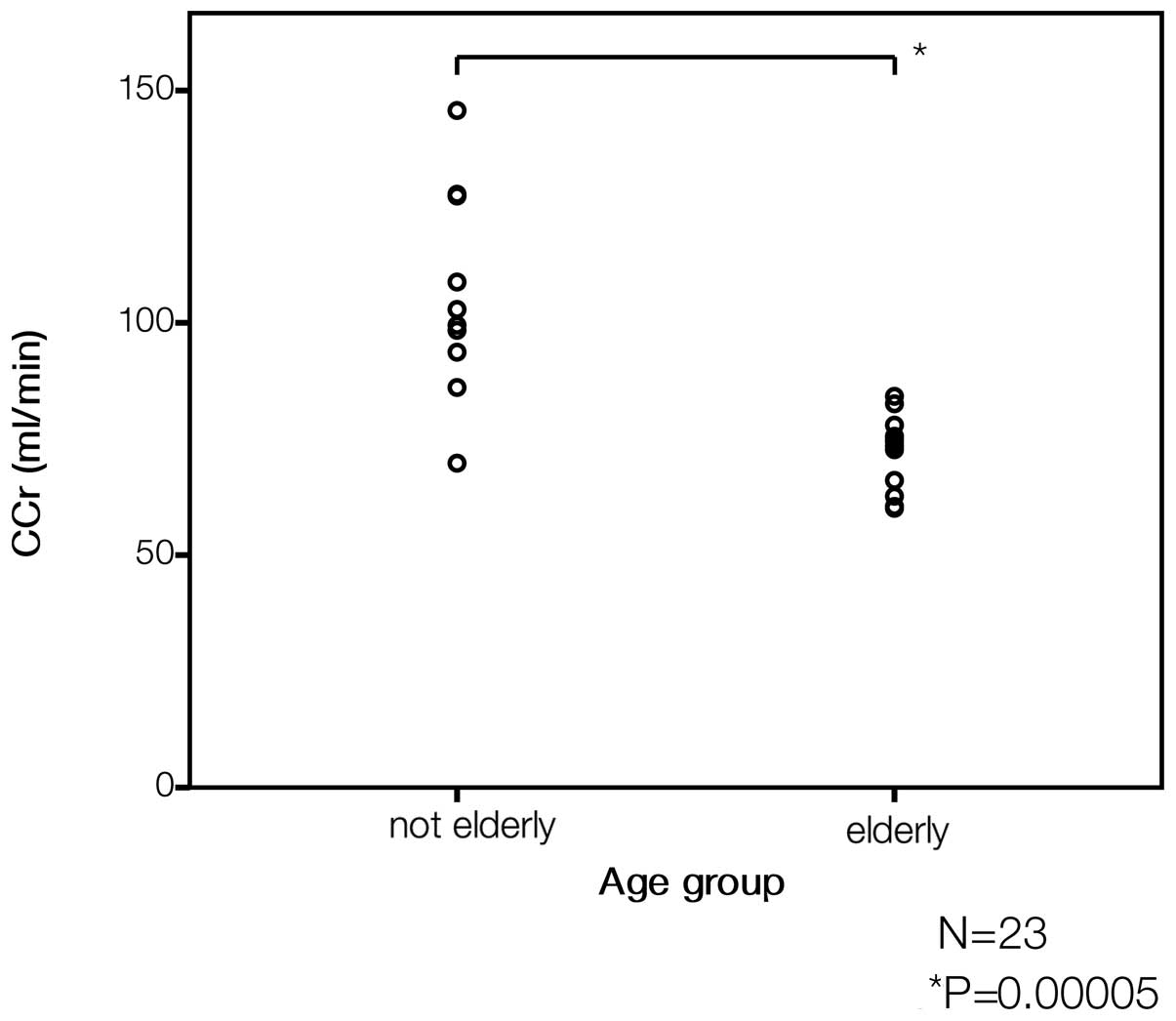Feasibility of adjuvant chemotherapy with S-1 consisting of a 4-week administration and a two-week rest period in patients with completely resected non-small cell lung cancer
- Authors:
- Published online on: August 6, 2012 https://doi.org/10.3892/mco.2012.6
- Pages: 124-130
Abstract
Introduction
Patients with completely resected non-small cell lung cancer (NSCLC) are at risk of relapse. Distant recurrence is a leading form of relapse in 15% of stage IA and in 60% of stage IIIA NSCLC patients (1). Previous meta-analyses of adjuvant chemotherapies have shown that the chemotherapies have survival benefit in patients with completely resected NSCLC (2,3). Cisplatin (CDDP)-based chemotherapies are recommended as the adjuvant chemotherapy in surgically resected stage II and IIIA NSCLC (4,5). Among the CDDP-based combination chemotherapies, chemotherapy with CDDP and vinorelbine haveproven to be beneficial for survival in NSCLC (6). Kato et al(7) and Hamada et al(8) demonstrated that tegafur-uracil (UFT) adjuvant therapy improved the overall survival period in stage I lung adenocarcinoma, however, this result has not yet been proven worldwide.
Adjuvant chemotherapies have increased survival rates by approximately 5% in 5 years in NSCLC, which does not appear to be satisfactory (3,9). Severe toxicities are occasionally observed in patients treated with CDDP-based chemotherapies, and chemotherapy-related death has been one of the major problems with adjuvant chemotherapies. Accordingly, development of a novel therapeutic strategy that is both safe and efficient is essential for patients with completely resected NSCLC.
S-1 is an oral 5-fluorouracil-(5-FU)-based agent containing tegafur, a 5-FU pro-drug, 5-chloro-2,4-dihydroxypyridine (CDHP), and potassium oxonate (Oxo) (10). CDHP is an inhibitor of dihydropyrimidine dehydrogenase, which degrades 5-FU. Oxo is distributed in the gastrointestinal tract and inhibits orotate phosphoribosyltransferase, a phosphoenzyme for 5-FU. Adjuvant chemotherapy with the single-agent S-1 has been proven to have a survival benefit in gastric cancer patients with a gastrectomy (11). S-1 is administered to patients for four weeks followed by a two-week rest period (conventional schedule). A modified schedule, in which S-1 is administered for two weeks followed by a one-week rest period (modified schedule), is used if patients on the conventional regimen experience severe toxicities (12).
Kim et al(13) reported that gastrectomy affected the pharmacokinetics of S-1 in patients with gastric cancer. By contrast, Kochi et al(14) demonstrated that gastrectomy had no effect on the plasma concentrations of 5-FU in patients treated with S-1. The effect of gastrectomy on the pharmacokinetics of S-1 remains controversial, while the pharmacokinetics of S-1 in patients with resected NSCLC is likely to be different compared to patients with resected gastric cancer.
In patients with advanced NSCLC, single-agent S-1 (conventional schedule) has been demonstrated to have a 22% response rate and to add 10.5 months to the median survival period (15). The feasibility of S-1 therapy was favorable to patients. Yano et al(16) reported that adjuvant chemotherapy with S-1 was feasible in patients with completely resected NSCLC. In that study, however, the conventional schedule of S-1 administration was not employed, and the schedule was modified. The feasibility of the conventional schedule of S-1 has, therefore, not previously evaluated in patients with completely resected NSCLC.
Considering that, as described above, the conventional administration schedule of S-1 has demonstrated efficacy in the treatment of advanced NSCLC (15), we hypothesized that the conventional schedule is likely to be efficient and feasible in patients with completely resected NSCLC. Consequently, the present study was conducted to evaluate the safety and efficacy of the conventional schedule of S-1 adjuvant chemotherapy in patients with completely resected NSCLC.
Materials and methods
Study design
The present study was designed as a multi-center, single-arm, clinical phase II study to evaluate the feasibility of S-1 adjuvant chemotherapy in patients with completely resected NSCLC, and was undertaken between May 2007 and October 2010 in Japan. The primary endpoint was relative dose intensity (RDI), representing the actual dose-planned dose ratio of S-1. The secondary endpoints were the safety and probability of 1-year disease-free survival (1y-DFS). The present study was designed to have 90% power for testing that RDI was not <50% at a one-side 5% significance level, if the actual RDI was >80%. Based on that design, the minimum sample size was calculated to be 21 patients, using the mathematical formula of one-stage phase II design of the South West Oncology Group (http://www.swogstat.org/statoolsout.html). Thirty patients were scheduled to enroll in the present study, while the study population was selected from three hospitals in Hokkaido, Japan. The present study was conducted in accordance with the Declaration of Helsinki. The protocol was approved by the local Institutional Review Board.
Patients
The present study comprised patients, who underwent curative resection with ND2a lymphadenectomy for NSCLC between 2007 and 2009, with diagnoses of pathological stage IB-IIIA NSCLC. The patients provided their signed written informed consent.
Eligible patients i) were 20–75 years old, ii) had an Eastern Cooperative Oncology Group (ECOG) performance status of 0 or 1, iii) had adequate organ function [leukocyte count >3.5×109 cells/l, platelet count >100×109 cells/l, hemoglobin >9.0 g/dl, aspartate and alanine aminotransferases (ASTs and ALTs) <2.0 × upper limit of normal (ULN), serum bilirubin <2.0 x ULN, serum creatinine <1.0 x ULN, BUN <25 mg/dl, creatinine clearance (CCr, which was calculated by the Cockcroft-Gault equation) >60 ml/min, PaO2>70 mmHg], iv) had undergone no prior chemotherapy for NSCLC, v), were within 8 weeks of surgery and vi ) had a life expectancy of >3 months.
Treatment
S-1 was administered to patients within 8 weeks of surgery. Patients received 40 mg/m2 S-1 orally twice daily; the dose was 80 mg/body/day when the body surface area was <1.25 m2, 100 mg/body/day for 1.25–1.50 m2 and 120 mg/body/day for >1.50 m2. S-1 was administered for 4 weeks followed by a two-week rest period. These cycles were repeated every 6 weeks, while the maximum treatment was 8 cycles.
Administration of S-1 was delayed if a patient had any of the following toxicities on Day 1: leukocyte count <3.0×109 cells/l, neutrophil count <1.5×109 cells/l, platelet count <100×109 cells/l, hemoglobin <8.0 g/dl, ASTs and ALTs >2.0 x ULN, serum bilirubin >2.0 x ULN, serum creatinine >1.0 x ULN or other non-hematological toxicities >grade 2.
The conventional schedule of S-1 was replaced by the modified schedule, consisting of a two-week administration of S-1 and a one-week rest period, when a patient had one of the following toxicities: leukocyte count <2.0x109 cells/l, neutrophil count <1.0x109 cells/l, platelet count <75x109 cells/l, hemoglobin <8.0 g/dl, ASTs and ALTs >2.0 x ULN, serum bilirubin >2.0 x ULN, serum creatinine >1.0 x ULN or other non-hematological toxicities >grade 3. In the modified schedule, the cycles were repeated every three weeks, while 2 cycles of the modified schedule were considered to be equivalent to 1 cycle of the conventional regimen.
When patients had suffered from the above-mentioned toxicities twice, the S-1 dose was reduced to 50 mg/body/day for <1.25 m2, 80 mg/body/day for 1.25–1.5 m2 and 100 mg/body/day for >1.5 m2. Patients received S-1 chemotherapy unless experiencing a relapse or was experienced the following discontinuation criteria presented: i) suffered from a third round of the indicated toxicities, ii) grade 4 hematological toxicities, iii) the creatinine increased to grade 2 or worse, iv) ASTs and ALTs increased to grade 3 or worse, v) other non-hematological toxicities at grade 4 or vi) the next chemotherapy cycle was delayed for >28 days.
Assessment of patients
Pathological stages of NSCLC were determined using the 6th edition of the Union for International Cancer Control Manual of Clinical Oncology (17). Toxicities were assessed according to the National Cancer Institute Common Terminology Criteria for Adverse Events version 3.0 (http://ctep.cancer.gov/reporting/ctc.html) (18). Adverse events were evaluated and blood tests were carried out at each cycle. Screening tests included hematology, blood chemistry and urinalysis. Disease-free survival (DFS) was determined by the time period between enrollment and recurrence. Computed tomography and tumor marker tests were performed at least every 6 months subsequent to enrollment. DFS in each patient was analyzed 1 year after surgery.
Statistical analysis
In the present study, P-values and confidence intervals (CI) were two-sided, and P<0.05 was considered to indicate a statistically significant difference. In the subgroup analysis, the median values of RDI were compared using the Mann-Whitney U test. The probability of 1y-DFS was estimated using the Kaplan-Meier method. The correlation between the two variables (RDI and age, RDI and CCr) was analyzed using the Spearman’s rank correlation test. The difference between CCr in older (>65 years) and younger (<65 years) groups was analyzed using the Student’s t-test. Statistical analysis was carried out using SPSS Statistics version 19.0.0 (IBM, Tokyo, Japan).
Results
Patient characteristics
Between May 2007 and October 2009, 28 patients (22 male and 6 female) were enrolled in the present study (Fig. 1 and Table I). The enrollment was terminated after interim analysis was carried out and RDI was confirmed not to meet the expectations.
In the present study, one of the 28 patients refused to be treated with S-1 after enrollment, thus never receiving S-1. This patient was included in the analysis of RDI and 1-y DFS, but excluded from the subgroup analysis. The median age of patients was 67.0 years, while 78.6% of the enrolled patients were males (Table I). In this study, 15 patients had a diagnosis of NSCLC at the pathological stage IB and 18 had adenocarcinoma.
Feasibility of S-1 chemotherapy
The relative dose intensity for 28 patients was 63.1% (95% CI, 48.6–77.7). Fourteen patients (50.0%) completed all 8 planned courses of S-1, whereas the remaining patients received an incomplete adjuvant chemotherapy. The average number of completed courses was 5.3 (95% CI, 4.1–6.5). A schedule modification was required for 10 patients (35.7%). Additionally, the dose was reduced for 7 (70.0%) of the 10 patients, requiring a schedule modification.
Fig. 2A shows a scatter diagram of the correlation between age and RDI in the 28 patients. Fig. 2B shows a scatter diagram of 23 patients, while 5 patients were excluded from the analysis for reasons other than toxicities: 4 patients terminated chemotherapy due to a recurrence or a simultaneous carcinoma; 1 patient refused to receive S-1 chemotherapy (excluded patients are represented as triangles in Fig. 2A). Considering the distribution in the scatter diagram, the RDI seemed to be lower in patients >65 years (R2=0.132; P=0.088; Spearman’s rank correlation test) (Fig. 2B). The patients were divided into groups of older (age >65 years) and younger patients (age ≤65 years), showing that the median RDI in the older patients was markedly lower compared to the younger patients (44.8 vs. 100%; P=0.013; Mann-Whitney U test) (Fig. 3).
Toxicity profiles
Adverse events in 27 eligible patients were analyzed. No grade 4 or 5 toxicity was observed (Table II), while 4 patients had grade 3 adverse events including anorexia, extrapyramidal disorder, pneumonitis and elevated serum amylase. In particular, 3/4 of patients had grade 3 non-hematological toxicities on Days 15–29. No grade 3 or worse hematological toxicity was observed in the present study. The most common adverse events were anorexia, fatigue, diarrhea and skin hyperpigmentation.
When the patients were divided by age as described above, grade 2 and 3 non-hematological events were more likely to be observed in the older compared to the younger group (Fig. 4). By contrast, the frequencies of hematological toxicities in the older and younger groups were similar. To determine the factor responsible for those differences, CCr was analyzed in each group. CCr values in older patients were lower compared to younger patients (Fig. 5), while CCr appeared to be correlated with RDI (P=0.07; R2=0.128; Spearman’s rank correlation test) (Fig. 6).
One-year DFS
The probability of DFS at 1 year was 85.7% (95% CI, 72.8–98.6) (Fig. 7). The average of 1y-DFS period was 343.4 days (95% CI, 323.1–363.6). Relapse was observed in 4 patients (14.3%). Of the 4 patients, 2 had stage IB NSCLC and 2 had stage IIB and IIIA.
Discussion
In the present study, the feasibility of chemotherapy with S-1 in patients with completely resected NSCLC was evaluated. When a novel agent is employed in an adjuvant chemotherapy, both efficacy and safety are of great interest. S-1 is an oral agent that was administered on an outpatient basis. It is reasonable to use S-1 in adjuvant chemotherapy of NSCLC, if S-1 has a favorable feasibility and efficacy equivalent to that of platinum-based chemotherapy. In the present study, four major findings were reported: i) the average of RDI was 63.1%, while a low S-1 RDI was observed in patients >65 years, ii) no grade 4 or worse toxicity was observed, although the older subgroup was more likely to have non-hematological grade 2 and 3 toxicities, iii) low CCr was observed in the older patients, possibly accounting for both the increase in non-hematological toxicities and the low RDI in the older patients and v) the 86% probability of 1y-DFS in the present study was acceptable.
In the present study, the RDI of S-1 was 63.1%, although only 50% of the patients completed chemotherapy with S-1, which was not satisfactory. In gastric cancer, Sakuramoto et al(11) demonstrated the survival benefit of adjuvant chemotherapy with S-1, as delineated above. In their large-scale study, 66% of patients completed chemotherapy with S-1, while 40% of patients required modification of the treatment schedule (11,12). The RDI in the present study seemed to be inferior to that in the large-scale study.
The subgroup analysis of our results revealed that patients >65 years had a markedly lower RDI compared to the remaining patients (Figs. 2 and 3). Aoyama et al (19) reported that in gastric cancer no difference was observed in the RDI of the adjuvant chemotherapy with S-1 in older (≥70 years old) and younger (<70 years old) patients with gastrectomy. However, Tsushima et al(20) demonstrated that median RDI in younger (≤65 years old) patients was likely to be lower compared to older (>65 years old) patients, including patients with unresectable gastric cancer. The conventional schedule of S-1 administration was employed in the two studies. Since the present study comprised no patients with gastrectomy, we referred to the results reported by Tsushima et al(20). These results suggest that age is likely to affect RDI in the conventional S-1 schedule in NSCLC.
Moreover, no grade 4 or worse toxicity was observed in the present study (Table II). The present toxicity profile appeared to be comparable to other studies, suggesting that S-1 may be used in outpatients with completely resected NSCLC. However, results of the present study suggest that the older patients were more likely to have grade 3 non-hematological toxicities, while the incidence of hematological toxicities was similar (Fig. 4).
In addition, lower CCr in elderly patients was likely to be associated with lower RDI (Figs. 5 and 6). Tsushima et al(20) reported that CCr affected the dose intensity of S-1 in advanced gastric cancer (12). Several studies have demonstrated that approximately 50% of CDHP, a component of S-1 preventing degradation of 5-FU, was excreted in urine, and that renal function affects 5-FU concentrations in patients with solid tumors (21–23). Moreover, Fujita et al(24) reported that the area under the curve for CDHP was significantly higher in older (≥75 years) compared to younger patients, due to reduced renal function. Accordingly, we hypothecized that lower CCr in older patients is likely to have affected the toxicity profile and RDI in the present study.
In order to increase RDI in elderly patients, we referred to studies in which S-1 schedule or dose modification was employed. Several studies demonstrated that schedule- or dose-modified S-1 therapy increased RDI in adjuvant chemotherapy with S-1 (25–28). Shin et al(29) reported a modified schedule in which S-1 was administered for two weeks followed by a one-week rest period to be preferable for older patients with advanced colorectal cancer. However, a phase I study of S-1 demonstrated that the recommended dose of S-1 was 30 mg/m2 for North American patients with advanced upper gastrointestinal cancer (30). Yano et al (16) demonstrated that in patients with resected NSCLC, the modified schedule of S-1 generated a preferable RDI (73.9%), as delineated above. Currently, most patients with NSCLC are >65 years, and a schedule or dose modification may be preferable for the adjuvant chemotherapy with S-1.
In the present study, the probability of 1y-DFS was 85.7% (Fig. 7), thus not lower than the outcome reported in the post-operative course (31). However, this study included patients with stage IB-IIIA NSCLC. We hypothesized that eligibility might slightly affect the probability of 1y-DFS, although the sample size was too small to estimate the survival benefit of chemotherapy with S-1. As described above, single-agent S-1 has been shown to provide a preferable response rate in advanced NSCLC, although the adverse effects appear to be slightly less severe compared to those of platinum-based chemotherapy, including combination chemotherapy with a platinum agent and S-1 (15,32–35). Thus, single-agent S-1 may be appropriate for patients with stage I NSCLC.
In conclusion, the present data suggest that single-agent S-1 in adjuvant chemotherapy often requires schedule or dose modification. The conventional S-1 schedule is not likely to be feasible in patients with completely resected NSCLC.
Acknowledgements
The authors thank Drs Yoshinori Minami, Satoshi Endoh, Satoshi Hayashi, Kiyoko Shibukawa, Kaori Ohnishi (Respiratory Center, Asahikawa Medical University, Asahikawa, Japan), Drs Kensuke Ishida, Shoko Takeuchi, Eri Toyoshima, Yasushi Yamamoto, Toshiyuki Ogasa, Shinobu Osanai (First Department of Internal Medicine, Asahikawa Medical University, Asahikawa, Japan), Drs Satoshi Hirata (Department of Operation, Asahikawa Medical University), and Dr Hiroyuki Aoki (Department of Respiratory Surgery, National Hospital Organization, Asahikawa Medical Center, Asahikawa, Japan) for their support and for the enrollment of patients in the present study.



